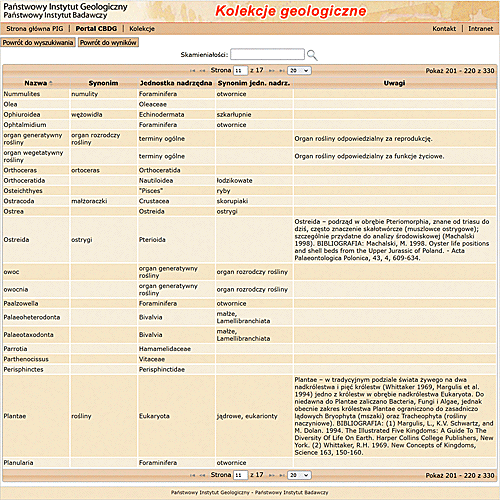Vocabularies of the Central Geological Database
 Aim of vocabularies
Aim of vocabularies
Basically, geological databases aim to provide the users with the possibility of an effective information search. Presenting geological data by means of information technology is not an easy task because of heterogeneous source data, ambiguous nomenclature and different terminological conventions applied. Such problems are solved by preparing vocabularies that become a standard accepted in a given computer system and sometimes nationwide. Their content must possibly be in conformity with source information and up-to-date professional terminology. Their structure must enable an effective data search.
In the process of creating the CBDG, several vocabularies were prepared and added to the database. Some vocabularies were obtained from other institutions (for instance, the vocabulary of Polish towns and cities from the Central Statistical Office), the others were adapted and expanded (for instance, the vocabulary of sheets of the Detailed Geological Map of Poland). Most vocabularies were prepared by the CBDG team, generally with the help of specialists from the PGI Departments and occasionally other institutions. The CBDG vocabularies are being modified and expanded to meet the requirements for developing the data collected in the system.
List of vocabularies
Out of several CBDG vocabularies, the most important ones are:
- the vocabulary of chronostratigraphic units,
- the vocabulary of climatostratigraphic units,
- the vocabulary of lithostratigraphic units of Poland,
- the vocabulary of fossils,
- the vocabulary of minerals,
- the vocabulary of rocks,
- the vocabulary of rock properties,
- the vocabulary of sedimentary structures,
- the vocabulary of tectonic structures,
- the vocabulary of properties of tectonic and sedimentary structures,
- the vocabulary of parameters of tectonic and sedimentary structures,
- the vocabulary of survey methods,
- the vocabulary of well-log surveys
- the vocabulary of institutions,
- the vocabulary of serial maps (1:50 000, 1:100 000, 1:200 000, 1:300 000),
- the vocabulary of structural units of Poland,
- the vocabulary of geographical regions of Poland,
- the vocabulary of Polish towns and cities (based on the Central Statistical Office documentation),
- the vocabulary of administrative units (based on the Central Statistical Office documentation).
 Chronostratigraphic Vocab.
Chronostratigraphic Vocab. Fossils Vocabulary
Fossils Vocabulary